| 2 August |
• yesterday • tomorrow |
| Optional Memorial of Saint Eusebius of Vercelli, Bishop; Optional Memorial of Saint Peter Julian Eymard, Priest |
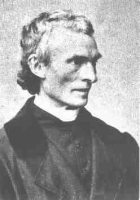
• Peter Julian Eymard
• Pierre-Julien Eymard
1 August (La Mure, Isère, France)
Peter grew up in a poor family during the anti-clerical, anti-Catholic aftermath of the French Revolution. His first attempt at the priesthood, against his family's wishes, ended when he had to withdraw from seminary due to illness; he never completely recovered his health. He returned, however, and was ordained on 20 July 1834 in the diocese of Grenoble, France. Joined the Marist Fathers on 20 August 1839. Friend of Saint John Mary Vianney. Provincial superior of the Society of Mary in 1845.
Peter had a strong Marian devotion, and travelled to the assorted Marian shrines and apparition sites in France. Organized lay societies under the direction of the Marists, preached and taught, and worked for Eucharistic devotion. He felt a call to found a new religious society, and founded the Congregation of the Blessed Sacrament in 1856, and the lay Servants of the Blessed Sacrament in 1858. His work encountered a series of setbacks, including have to close his nascent houses and move twice, and the houses not being able to support themselves financially. However, his vision of priests, deacons, sisters, and lay people dedicated to the spiritual values celebrated in the Mass and prayer before the Blessed Sacrament anticipated many of the renewals brought about by Vatican Councils I and II.
Late in life, during a lengthy retreat in Rome, he became more mystical as he came in closer communion with the love of Christ. Six volumes of his personal letters, and nine volumes of his meditations have been printed in English.
4 February 1811 at La Mure, France
1 August 1868 at La Mure, Isère, France following a stroke
9 December 1962 by Pope John XXIII
We believe in the love of God for us. To believe in love is everything. It is not enough to believe in the Truth. We must believe in Love and Love is our Lord in the Blessed Sacrament. That is the faith that makes our Lord loved. Ask for this pure and simple faith in the Eucharist. Men will teach you; but only Jesus will give you the grace to believe in Him. You have the Eucharist. What more do you want? - Saint Peter Julian Eymund
If the love of Jesus in the Most Blessed Sacrament does not win our hearts, Jesus is vanquished! Our ingratitude is greater than His Goodness our malice is more powerful than His Charity. - Saint Peter Julian Eymund
Every time we come into the presence of the Eucharist we may say: This precious Testament cost Jesus Christ His life. For the Eucharist is a testament, a legacy which becomes valid only at the death of the testator. Our Lord thereby shows us His boundless love, for He Himself said there is no greater proof of love than to lay down one's life for one's friends. - Saint Peter Julian Eymard
The Holy Eucharist is the perfect expression of the love of Jesus Christ for man, since It is the quintessence of all the mysteries of His Life. - Saint Peter Julian Eymard
He loves, He hopes, He waits. If He came down on our altars on certain days only, some sinner, on being moved to repentance, might have to look for Him, and not finding Him, might have to wait. Our Lord prefers to wait Himself for the sinner for years rather than keep him waiting one instant. - Saint Peter Julian Eymard
How kind is our Sacramental Jesus! He welcomes you at any hour of the day or night. His Love never knows rest. He is always most gentle towards you. When you visit Him, He forgets your sins and speaks only of His joy, His tenderness, and His Love. By the reception He gives to you, one would think He has need of you to make Him happy. - Saint Peter Julian Eymard
https://catholicsaints.info/saint-peter-julian-eymund/
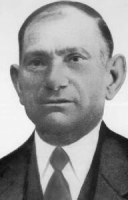
• El Pele
• Zefferino Giménez Malla
• Zefyrinus Giménez Malla
Lifelong layman. He had little education, and was possibly illiterate, but his native intelligence was obvious to all who knew him, and he was known for his love of nature. Baptised into the Church as an adult. Married to Teresa Jimenez Castro in 1912 at age 51. Adoptive father of his niece Pepita. He became a mule-trader around 1920, and did so well he was able to settle in the town of Barbastro as a successful businessman. Widower in 1922. City councilman in Barbastro. Catechist, Eucharistic minister, choir director and rosary leader, Ceferino developed a reputation for holiness, and people would be on their best behavior around him. Advisor to his bishop. Dominican tertiary in 1926. A Gitano (Spanish Gypsy), he worked to improve relations between Gypsies and non-Gypsies. He was arrested during the persecutions of the Spanish Civil War for hiding priests. He was offered his freedom if he would renounce his faith and throw away his rosary; he declined. Martyr.
1861 in Benavent de Segria, Lérida Province, Catalonia, Spain
• shot by firing squad on 8 August 1936 in the cemetery of Barbastro, Spain
• buried there in an unmarked grave
• after the war his body was exhumed and re-interred next to his wife
• 4 May 1997 by Pope John Paul II
• first beatified Romani
• Romani
• Sinti
"I have called you friends" (John 15:15) Also in Barbastro, the Gypsy Ceferino Giménez Malla, known as "El Pelé" died for the faith in which he had lived. His life shows how Christ is present in the various peoples and races, and that all are called to holiness which is attained by keeping his commandments and remaining in his love (cf. John 15:11). El Pelé was generous and welcoming to the poor, despite his own poverty; honest in his activities, faithful to his people and his Gypsy race, endowed with an extraordinary natural intelligence and the gift of counsel. He was above all a man of deep religious beliefs.
His frequent participation at Mass, devotion to the Bessed Virgin with the recitation of the rosary, and his membership in various Catholic associations helped him to firmly love God and his neighbour. Thus even at the risk of his own life, he did not hesitate to defend a priest who was about to be arrested, and for doing so he was put in prison where he never ceased to pray and was later shot, as he clutched his Rosary in his hands. Blessed Ceferino Giménez Malla knew how to sow peace and solidarity among his own, often mediating in the conflicts that relations between Gypsies and farmers sometimes involve, showing that Christ's love is not limited by race or culture. Today "El Pelé" intercedes for all before our common Father, and the Church proposes him as a model to follow and a significant example of the universal vocation to holiness, especially for Gypsies, who have close cultural and ethnic ties with him. - Pope John Paul II, homily of the beatification Mass for Blessed Ceferino, Sunday 4 May 1997
https://catholicsaints.info/blessed-ceferino-jimenez-malla/
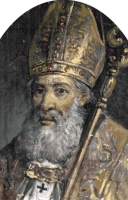
Eusebi, Eusebio, Eusebe, Euzebiusz, Euzebije
• 1 August (in the Piedmont region of Italy)
• 15 December (consecration of Saint Eusebius)
Born to a pious family - his father died a martyrs when the Eusebius was small, he was baptized in Rome, Italy by Pope Saint Eusebius, his mother, Saint Restituta, died a martyr in her old age, and his sister Eusebia became a nun and mother superior of a monastery in Vercelli, Italy that Eusebius founded. Eusebius studied in Rome; one of his fellow seminarians was the future Pope Saint Liberius. Eusebius was ordained priest and lector in Rome. Chosen as the first bishop of Vercelli, Italy, he was consecrated on 16 December 340 by Pope Saint Julius I.
As bishop, Eusebius lived with and followed the same discipline as his priests. He attended the synod of Milan, Italy in 355. He was exiled for eight years by emperor Constantius to Palestine and Cappadocia for his strong opposition to Arianism; he spent part of the time in prison, and as soon as he returned, he began preaching against Arianism. Friend of Saint Athanasius of Alexandria, and attended a synod organized by him in Alexandria. A profilic writer according to his contemporaries, none of his works have survived. May have been martyred by Arians, but reports vary; many consider him a martyr as he may have died as a result of his sufferings in exile.
283 at Sardinia
1 August 371 in Vercelli, Italy
• Congregation of the Daughters of Saint Eusebius
• Berzo Demo, Italy
• Piedmont, Italy
• Vercelli, Italy
https://catholicsaints.info/saint-eusebius-of-vercelli/

• La Negrita
• The Little Black One
• Virgin de los Angeles
The image of Our Lady of the Angels is only about three inches high, and is carved in a simple fashion on dark stone. She has a round, sweet face, slanted eyes and a delicate mouth. Her coloring is leaden, with scattered golden sparkles. She carries the Christ Child on her left arm. Only the faces of Mary and the Child are visible; the rest is covered by a cloak that is gathered in pleats. The statuette is displayed in a large gold monstrance that surrounds it and enlarges its appearance.
While searching for firewood on 2 August 1635, the feast of the Holy Angels, a poor mestizo woman named Juana Pereira discovered this small image of the Virgin sitting beside the footpath near Cartago, Costa Rica. Juana took it home with her, but it soon disappeared only to be re-discovered at the same place beside the same path. The statue repeated this behavior five more times - taken to homes and then the parish church - and returning on its own to the site where Juana found it. The locals finally took this to mean that Our Lady wanted a shrine built there, and so it was.
The shrine soon became a point of pilgrimage, especially for the poor and outcast. The image was solemnly crowned in 1926. In 1935 Pope Pius XI declared the shrine of the Queen of Angels a basilica. The stone on which the statue was originally sitting is in the basilica, and is being slowly worn away by the touch of the hands of the pilgrims. A spring of water appeared from beneath the stone, and its waters carried away to heal the sick.
• Costa Rica
• diocese of Getafe, Spain
https://catholicsaints.info/our-lady-of-the-angels/

Studied at the seminary of Pozzuoli, Italy where he was noted for his personal piety and stood out as an exceptional student. Priest in the Diocese of Pozzuoli, Italy, ordained on 20 September 1913. Parish priest in Pianura, Italy. Founded the Society of Divine Vocations (Vocationists) in 1919 which encouraged and supported those discerning a call to the priesthood and religious life. The Vocationists continue their work in Italy, France, Brazil, Argentina, the United States, Nigeria, India, the Philippines, Madagascar, Colombia and Ecuador.
18 January 1891 in Pianura, Naples, Italy
• 2 August 1955 in Pianura, Naples, Italy of natural causes
• re-buried at the Vocationist mother-house at Pianura on 14 April 1956
• 7 May 2011 by Pope Benedict XVI
• the beatification miracle involved the 1998 healing of the carcinoma of a 59-year-old woman
• 15 May 2022 by Pope Francis
• the canonization miracle involved the 21 April 2016 healing of a young Vocationist religious who suffered from epilepsy, seizures, serious rhabdomiliosis, pneumonia with ingestis, acute respiratory failure, and was in a coma at the time
https://catholicsaints.info/saint-giustino-maria-russolillo/
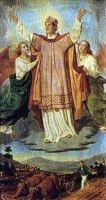
Sereno, Clear (translation of his name)
• 1st Sunday in August (Biandrate, Italy)
• 11 August (Marseille, France)
Bishop of Marseille, France c.595. Correspondent with Saint Gregory the Great; four of their letters have survived and provide what little we know about Serenus. He questioned the use of sacred images, and destroyed some icons in his cathedral to stop what he considered a tendency to idolatry, especially by people who came from outside the port city, but Pope Gregory convinced him of their value in catechising the illiterate. Assisted Saint Augustine of Canterbury on his mission to England in 596. Died while returning to Marseille from a visit to Rome, Italy.
• c.606 near Biandrate, Piedmont, Italy of natural causes
• buried in a field near Biandrate, and location of his grave was lost
• years later his grave was dug up by a farmer working the field
• relics enshrined in the church of San Columba in Biandrate
• relics re-enshrined in an urn in 1678
• for good weather
• for good harvests
• Biandrate, Italy
https://catholicsaints.info/saint-serenus-of-marseille/
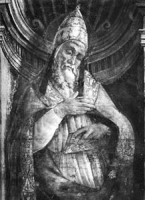
Son of Jovius; little else known of his early life. Archdeacon under Pope Lucius I. Elected 23rd pope in 254. Explicitly proclaimed the primacy of the diocese of Rome in matters of theology, and the current understanding of Christ's statement to Saint Peter: "You are Peter, and upon this rock I will build My Church." He condemned the Carthaginian practice of re-baptizing heretics, and accepted baptisms performed by heretics when the convert had acted in good faith; he corrected Saint Cyprian's thinking on the matter. Ordered that there be special clothing (vestments) for use in liturgy, that priests not conduct Mass in street clothes, and not wear their vestments into the streets. Often listed as a martyr in old records, but modern scholarship has found no evidence of it.
Roman
12 May 254
• 2 August 257 of natural causes
• buried in the papal crypt of Callistus on the Appian Way
• transferred by Pope Saint Paul I to Saint Stephen's monastery
Fiano Romano, Italy
being murdered at an altar
https://catholicsaints.info/pope-saint-stephen-i/
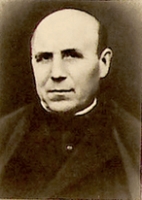
13 August as one of the Martyred Claretians of Barbastro
Born to a pious family; he became a Claretian priest, as did two of his brothers. He joined the Claretians in 1886. Studied at Santo Domingo de la Calzada. Ordained in 1898. Novice master. Worked to reduce the spread of tuberculosis, which was spreadly wildly at the time. Superior of communities in the Spanish cities of Barcelona, Cartagena and Zaragoza. Noted preacher of home missions. Known for his devotion to the Blessed Virgin Mary, the rules of his Order, and passing on Claretian spirituality to younger members and seminarians. Martyred in the persecutions of the Spanish Civil War.
4 February 1875 in Allo, Navarra, Spain
shot on 2 August 1936 at the gates of the cemetery in Barbastro, Huesca, Spain
25 October 1992 by Pope John Paul II
https://catholicsaints.info/blessed-felipe-de-jesus-munarriz-azcona/
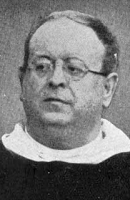
Member of the Dominicans. Studied at the Dominican convents of Padron and Corias in Asturias, Spain, and later at university in Barcelona, Spain. Ordained a priest in 1905 in Salamanca, Spain. Teacher for several years in Oviedo, Spain. Assigned in 1912 led the restoration of the Dominican presence in the province of Aragon, Spain. Imprisoned on 1 July 1936 for the crime of bring a priest; he spent his last night praying and writing a final letter to his mother. Martyred in the Spanish Civil War while praying for the forgiveness of his executioners.
21 November 1881 in Hijár, Teruel, Spain
• shot on 2 August 1936 in Híjar, Teruel, Spain
• buried at the Calanda cemetery
• re-interred at the Dominican Zaragoza College of Santa Rosa
• re-interred in the Cardinal Xavierre convent in Zaragoza in 1962
11 March 2001 by Pope John Paul II
https://catholicsaints.info/blessed-francisco-calvo-burillo/
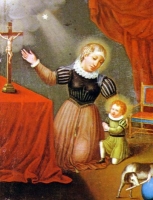
Jane, Joan, Joanna
Born to the Castilian nobility, the daughter of Felix de Caleruega, constable of Castile. Lay woman noted for her physical and spiritual beauty. Married to Felix de Guzman, governor of Calaruega, Burgos, Spain c.1165. Mother of four. Her oldest son, Venerable Anthony, became a priest, the middle son was Blessed Manés, and the youngest was Saint Dominic de Guzman. When pregnant with Dominic, she had a vision that her unborn child was a dog who would set the world on fire with a torch it carried in its mouth; a dog bearing a torch in its mouth became a symbol for the Dominicans. Popular devotion to Joan sprang up almost immediately upon her death.
at Castle Aza, Aranda, Old Castile, Spain
c.1190 at Celeruga, Spain of natural causes
1828 by Pope Leo XII (cultus confirmed)
https://catholicsaints.info/blessed-juana-de-aza/
Pedro of Bourges
Benedictine monk at the Cluniac Saint-Orens Abbey in Auch, France. He and several brother monks moved to Castile at the request of Archbishop Bernardo de Salvivat of Toledo, Spain in order to bring the Cluniac reform to the region. Arch-deacon of the Toledo. Bishop of Osma, Spain in 1101; the area was newly freed of Muslim rule. Pedro was known for his personal piety, his endless hard work, and his ministry and support of the poor, the sick and the imprisoned. Started construction of the Cathedral of Santa Maria de Osma. Some sources say he was chosen archbishop of Toledo in 1109, but that’s questionable. Died while attending the funeral of King Alfonso VI.
Bourges, France
• 1109 in the house of the bishop of Palencia, Castile, Spain of natural causes, having contracted a disease at the monastery of Sahagún
• interred in the cathedral of Burgo de Osma
https://catholicsaints.info/saint-pedro-de-osma/

13 August as one of the Martyred Claretians of Barbastro
Born to a poor peasant family. Joined the Claretian at the school in Alagón in 1889. Priest, ordained in Miranda de Ebro, Spain in 1901. Superior of the house at Olesa de Montserrat in 1907. Treasurer and administrator of houses in several cities beginning in 1913. Martyred in the persecutions of the Spanish Civil War.
12 September 1875 in Muro de Aguas, Logroño, Spain
shot on 2 August 1936 at the gates of the cemetery in Barbastro, Huesca, Spain
25 October 1992 by Pope John Paul II
https://catholicsaints.info/blessed-leoncio-perez-ramos/
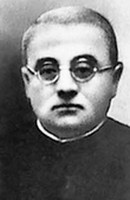
13 August as one of the Martyred Claretians of Barbastro
Joined the Claretians in 1893. Ordained in 1906 in Zaragoza, Spain. Superior of the community in Calatayud, Spain in 1913. Began teaching moral theology in Barbastro, Spain in 1916; he worked there for 18 years. Prefect of students in Barbastro in 1934. Noted teacher, preacher and spiritual director. Martyred in the persecutions of the Spanish Civil War.
17 February 1880 in Oviedo, Asturias, Spain
shot on 2 August 1936 at the gates of the cemetery in Barbastro, Huesca, Spain
25 October 1992 by Pope John Paul II
https://catholicsaints.info/blessed-juan-diaz-nosti/
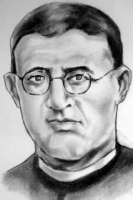
Joined the Vincentians on 19 August 1911, making his profession on 1 January 1914. Ordained on 10 August 1921. Professor at the Vincentian Apostolic College in Teruel, and the in 1935 at Alcorisa, Spain. Regardless of his assignment, he never forgot that his first vocation was to be a priest, leading people to Christ. Martyred in the Spanish Civil War.
18 March 1895 in Villarmentero, Burgos, Spain
• beaten to death with a hand tool on 2 August 1936 in Las Planas de Oliete, Teruel, Spain
• body thrown off a cliff
13 October 2013 by Pope Francis
https://catholicsaints.info/blessed-leoncio-perez-nebreda/
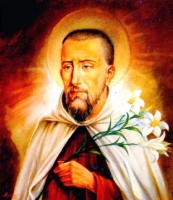
Born to the nobility. Known as a pious child, Frederic joined the Franciscans as soon as they would taken him. Hermit on the Magdalena peninsula of Sicily near the area of modern Plemmirio, Contrada Isola. Miracle worker, healer, exorcist with the gift of prophesy.
c.1255 in Syracuse, Sicily, Italy
2 August 1335 of natural causes
• popular devotion began immediately, and the diocese started the process in 1336
• in 1761 Bishop Giuseppe Antonio De Requesens ordered the canonical recognition of the relics of Blessed Frederic
https://catholicsaints.info/blessed-frederic-campisani/

Son of Antonio and Dolores. Studied with Capuchin tertiaries. Joined the Capuchin Tertiary Fathers and Brothers of Our Lady of Sorrows in 1928. Ordained a priest in 1934. Studied in Belgium and France. Studied medicine at the Central University of Madrid. Martyred in the Spanish Civil War for the crime of being a priest.
10 October 1911 in Alcalalí, Alicante, Spain
shot on 2 August 1936 against the wall of the Prince of Asturias Reformatory in Madrid, Spain
11 March 2001 by Pope John Paul II
https://catholicsaints.info/blessed-francisco-tomas-serer/
• Gundekar Aureatensis
• Gundekar Eystetensis
• Gundechar, Gundecharus, Guntaker, Gunzo
Born to the Frankish nobility, the son of Reginher and Irmingart. Moved to Bavaria, Germany as a child. Educated at Cathedral School in Eichstätt, Germany. Chaplain to Empress Agnes in 1045. Bishop of Eichstätt on 20 August 1057.
10 August 1019 in Germany
• 2 August 1075 in Eichstätt, Germany
• interred in the Baptist chapel of the cathedral of Eichstätt
• relics relocated to an above ground tomb in September 1309
https://catholicsaints.info/blessed-gundekar-of-eichstatt/
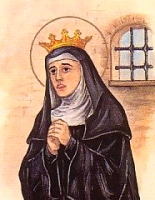
Alfreda, Etelreda
A princess, the daughter of King Offa of Mercia. Betrothed to Saint Ethelbert of East Anglia. After the murder of Ethelbert, Etheldritha moved to Croyland, England and lived as a Benedictine anchoress.
795 in Mercia (in modern England)
• c.835 in Croyland, England of natural causes
• relics enshrined in Croyland Abbey
• relics destroyed in 870 by Danish raiders
woman in a black Benedictine habit and a crown
https://catholicsaints.info/saint-etheldritha/
Sativola, Sadfyl
Sister of Saint Urith and Saint Juthwara. Virgin-martyr, murdered by reapers at the instigation of the girl's step-mother.
near Exeter, England
• beheaded with a scythe, date unknown
• a well sprang up at the site of her martyrdom, and its waters were reputed to heal
• buried outside the city of Exeter, England
• her grave became a place of pilgrimage and healing
• the church of Saint Sidwell still exists and was re-built following bombings in World War II
• scythe
• well
https://catholicsaints.info/saint-sidwell/
Betario, Boetharius, Bohaire
Studied philosophy at the chapter school of Chartres, France. Monk. Priest. Hermit. Court chaplain to King Clotaire II. Reluctant bishop of Chartres, France, c.595. Directed the defenses of Chartres during a siege by Theodoric II of Burgundy; the city fell, Betharius was captured but released after he miraculously healed some Burgundian soldiers. Attended the Council of Sens.
Rome, Italy
c.623 of natural causes
https://catholicsaints.info/saint-betharius-of-chartres/
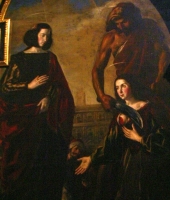
Daughter of a noble of Toledo, Spain who made a private vow of chastity and dedication to God. To escape the persecutions of Diocletian, she fled to Siero, Burgos, Spain. She was seized there, dragged to court, tortured, and executed when she would not renounce her faith. Martyr.
beheaded c.304 at Burgos, Spain
https://catholicsaints.info/saint-centolla-of-burgos/
Rutilio
Rutilius traveled extensively to avoid the persecutions of Decius, sometimes hiding, sometimes bribing officials to leave him alone, but never giving up his faith. He was finally captured, tortured and martyred.
North Africa
burned at the stake in 250 in a small town in northern Africa
https://catholicsaints.info/saint-rutilius/
An indulgence which may be gained in any church so designated by the bishop, by all the faithful who after Confession and Holy Communion, visit such churches between noon of 1 August and midnight of 2 August, or on the Sunday following. The indulgence is toties quoties and is applicable to the souls in Purgatory.
https://catholicsaints.info/portiuncula-indulgence/
Noted scholar. Tutor to King Alfred. Archbishop of Canterbury, England. Restored the Church in England after the attacks of pagan Danes. The hermitage at Plemstall, Plegmundstow, was named after him.
Cheshire, England
923 of natural causes
https://catholicsaints.info/saint-plegmund/
Auspice
First bishop of Apt, France in the late 1st century, consecrated by Pope Saint Clement I.
https://catholicsaints.info/saint-auspicius-of-apt/
Second century Bishop of Padua, Italy. Known as a miracle worker.
https://catholicsaints.info/saint-maximus-of-padua/
Thousands of people were murdered in the anti-Catholic persecutions of the Spanish Civil War from 1934 to 1939. I have pages on each of them, but in most cases I have only found very minimal information. They are available on the CatholicSaints.Info site through these links:
• Blessed Fernando Olmedo Reguera
• Francesc Company Torrelles
• Francisca Pons Sarda
• Francisco Manzano Cruz
• Blessed José Giménez Reyes
• José Peris Ramos
• Martí Anglés Oliveras
• Blessed Miguel Amaro Rodríguez
CatholicSaints.Info Portable Edition